Moule Lin
PreP-OCR: A Complete Pipeline for Document Image Restoration and Enhanced OCR Accuracy
May 28, 2025Abstract:This paper introduces PreP-OCR, a two-stage pipeline that combines document image restoration with semantic-aware post-OCR correction to enhance both visual clarity and textual consistency, thereby improving text extraction from degraded historical documents. First, we synthesize document-image pairs from plaintext, rendering them with diverse fonts and layouts and then applying a randomly ordered set of degradation operations. An image restoration model is trained on this synthetic data, using multi-directional patch extraction and fusion to process large images. Second, a ByT5 post-OCR model, fine-tuned on synthetic historical text pairs, addresses remaining OCR errors. Detailed experiments on 13,831 pages of real historical documents in English, French, and Spanish show that the PreP-OCR pipeline reduces character error rates by 63.9-70.3% compared to OCR on raw images. Our pipeline demonstrates the potential of integrating image restoration with linguistic error correction for digitizing historical archives.
Stochastic Weight Sharing for Bayesian Neural Networks
May 23, 2025Abstract:While offering a principled framework for uncertainty quantification in deep learning, the employment of Bayesian Neural Networks (BNNs) is still constrained by their increased computational requirements and the convergence difficulties when training very deep, state-of-the-art architectures. In this work, we reinterpret weight-sharing quantization techniques from a stochastic perspective in the context of training and inference with Bayesian Neural Networks (BNNs). Specifically, we leverage 2D adaptive Gaussian distributions, Wasserstein distance estimations, and alpha blending to encode the stochastic behaviour of a BNN in a lower dimensional, soft Gaussian representation. Through extensive empirical investigation, we demonstrate that our approach significantly reduces the computational overhead inherent in Bayesian learning by several orders of magnitude, enabling the efficient Bayesian training of large-scale models, such as ResNet-101 and Vision Transformer (VIT). On various computer vision benchmarks including CIFAR10, CIFAR100, and ImageNet1k. Our approach compresses model parameters by approximately 50x and reduces model size by 75, while achieving accuracy and uncertainty estimations comparable to the state-of-the-art.
Multi-Scale U-Shape MLP for Hyperspectral Image Classification
Jul 05, 2023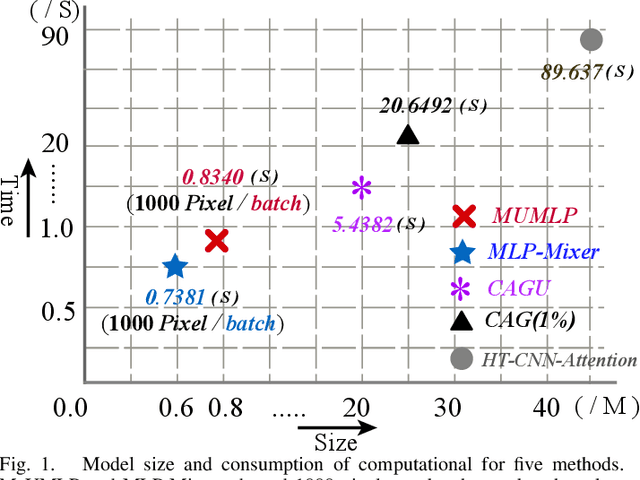
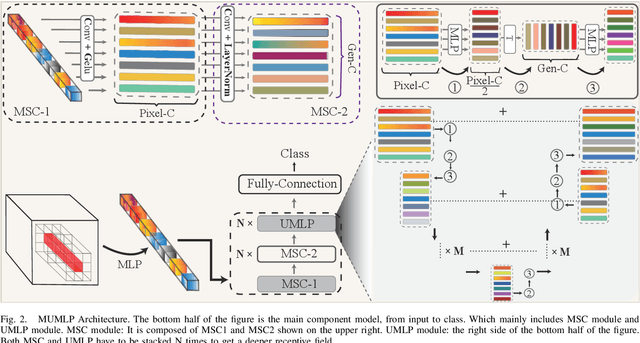
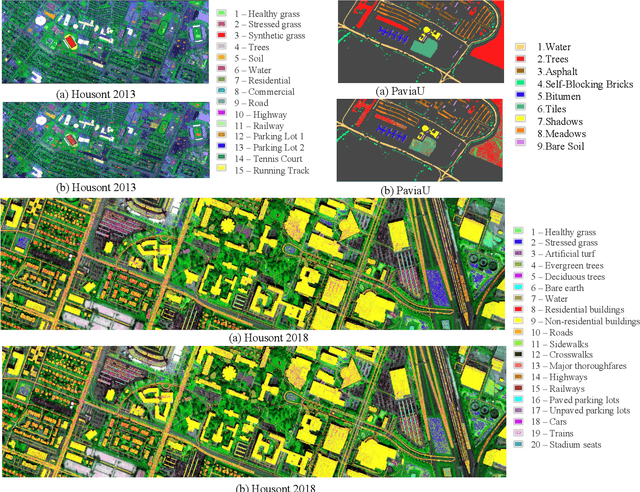

Abstract:Hyperspectral images have significant applications in various domains, since they register numerous semantic and spatial information in the spectral band with spatial variability of spectral signatures. Two critical challenges in identifying pixels of the hyperspectral image are respectively representing the correlated information among the local and global, as well as the abundant parameters of the model. To tackle this challenge, we propose a Multi-Scale U-shape Multi-Layer Perceptron (MUMLP) a model consisting of the designed MSC (Multi-Scale Channel) block and the UMLP (U-shape Multi-Layer Perceptron) structure. MSC transforms the channel dimension and mixes spectral band feature to embed the deep-level representation adequately. UMLP is designed by the encoder-decoder structure with multi-layer perceptron layers, which is capable of compressing the large-scale parameters. Extensive experiments are conducted to demonstrate our model can outperform state-of-the-art methods across-the-board on three wide-adopted public datasets, namely Pavia University, Houston 2013 and Houston 2018
* 5 pages
Optimized Vectorizing of Building Structures with Swap: High-Efficiency Convolutional Channel-Swap Hybridization Strategy
Jun 26, 2023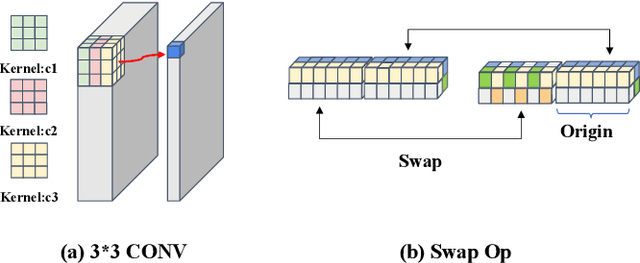
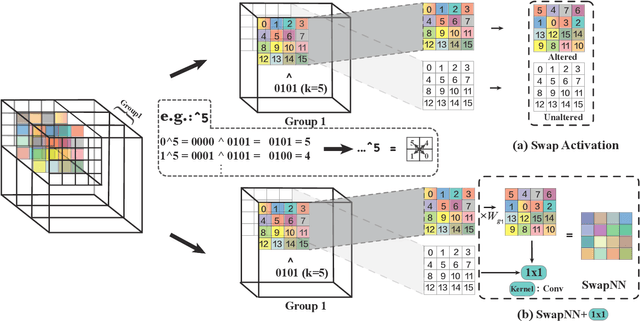
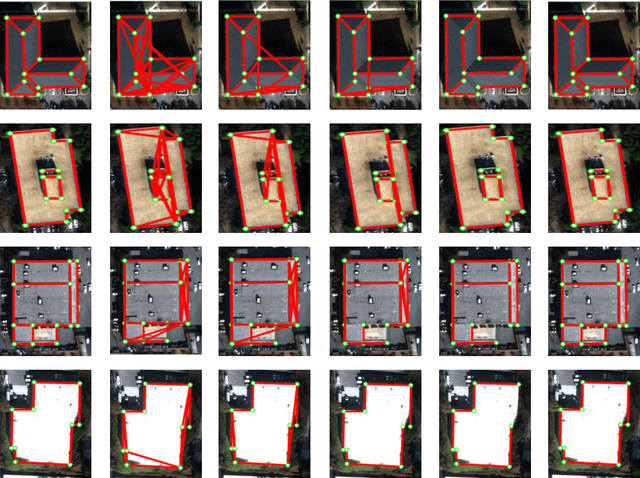
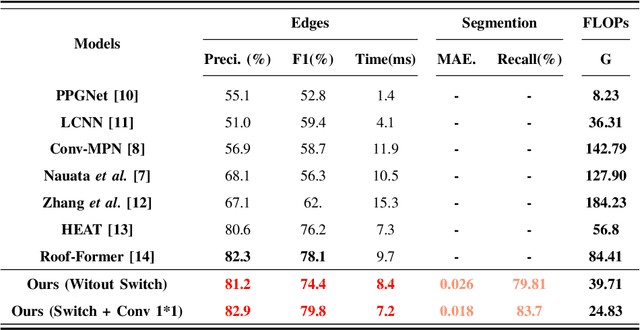
Abstract:The building planar graph reconstruction, a.k.a. footprint reconstruction, which lies in the domain of computer vision and geoinformatics, has been long afflicted with the challenge of redundant parameters in conventional convolutional models. Therefore, in this paper, we proposed an advanced and adaptive shift architecture, namely the Swap operation, which incorporates non-exponential growth parameters while retaining analogous functionalities to integrate local feature spatial information, resembling a high-dimensional convolution operator. The Swap, cross-channel operation, architecture implements the XOR operation to alternately exchange adjacent or diagonal features, and then blends alternating channels through a 1x1 convolution operation to consolidate information from different channels. The SwapNN architecture, on the other hand, incorporates a group-based parameter-sharing mechanism inspired by the convolutional neural network process and thereby significantly reducing the number of parameters. We validated our proposed approach through experiments on the SpaceNet corpus, a publicly available dataset annotated with 2,001 buildings across the cities of Los Angeles, Las Vegas, and Paris. Our results demonstrate the effectiveness of this innovative architecture in building planar graph reconstruction from 2D building images.
 Add to Chrome
Add to Chrome Add to Firefox
Add to Firefox Add to Edge
Add to Edge